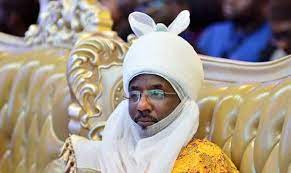The Eid-el-Fitr Sallah celebrations in Kano continued in a peaceful atmosphere as Emir Muhammadu Sanusi II revived the 1903 traditional Hawan Nassarawa homage—a cherished cultural heritage of the Dabo clan—by paying respects to Governor Abba Kabir Yusuf at the Government House.
Grassroots Parrot had reported how the Kano State Police Command banned the Durbar activities during the upcoming 2025 Eid-El-Fitr celebrations, citing potential security risks and a preemptive move to maintain public safety.
The Commissioner of Police in the state, CP Ibrahim Adamu Bakori, stated that the decision followed extensive consultations with state government officials, security stakeholders, and community leaders.
Thereafter, Emir Sanusi affirmed that the decision was made in the best interest of enduring peace and development in the state, adding that “the annual celebration it is not a matter of life and death.”
“Peace is the foundation of progress and development in any society,” the Emir stated. “We have, therefore, accepted to withdraw all planned activities of the emirate related to the colorful Durbar, which has been inscribed by UNESCO as an intangible heritage of humanity.”
READ ALSO: Salah Durbar Ban Best Interest Of Kano – Emir Sanusi
However, in compliance with security restrictions on the Sallah Durbar and to prevent potential security breaches, Emir Sanusi opted against the traditional horse-riding procession and reduced the number of accompanying traditional titleholders, a practice that had been adopted since 1940.
In addition to foregoing the horse ride, Emir Sanusi arrived at the Government House in an exotic vehicle convoy, deliberately avoiding the usual state road routes as a strategic measure to prevent any possible conflicts.
Providing historical context, Professor Tijjani Naniya, a historian at Bayero University, Kano, explained that before 1940, the Emir, as the head of the Native Authority, only paid a formal visit to the Governor’s residence and then returned to his palace.
“Before 1940, there was no Wajen Kano (outskirts of the city), and as head of the Native Authority, the Emir would visit the Government House solely to brief the Governor on the year’s developments before returning to his palace,” Professor Naniya stated.
“However, by 1940, as Wajen Kano was established and new settlers—primarily Hausas but not of Kano origin—resided there, the Emir needed to extend his presence to them. This led to the introduction of the Hawan Nassarawa horse-riding procession.”
READ ALSO: Emir Sanusi Urges Peace Amid Tensions Over Reinstatement
Regarding the security restrictions, Professor Naniya clarified that the police had specifically prohibited the procession of horses in any form. In compliance with this directive, the Emir refrained from riding horses and instead used vehicles to pay homage to the Governor.
“What was banned was the Emir riding on horseback and passing through state roads, which could have created security challenges. However, by reverting to the original form of the Hawan Nassarawa tradition, there was no violation,” he explained.
“The Emir’s visit was limited to the Government House, as opposed to the usual Hawan Nassarawa, where he would ride horses, tour Kano, greet residents, and then return to his palace,” Professor Naniya concluded.

